
AVIATION
CONSUMER
PROTECTION
FewU.S.Aircraft
HaveLavatories
Designedto
Accommodate
Passengerswith
ReducedMobility
Accessible Version
ReporttoCongressionalCommittees
January 2020
GAO-20-258
United States Government Accountability Office
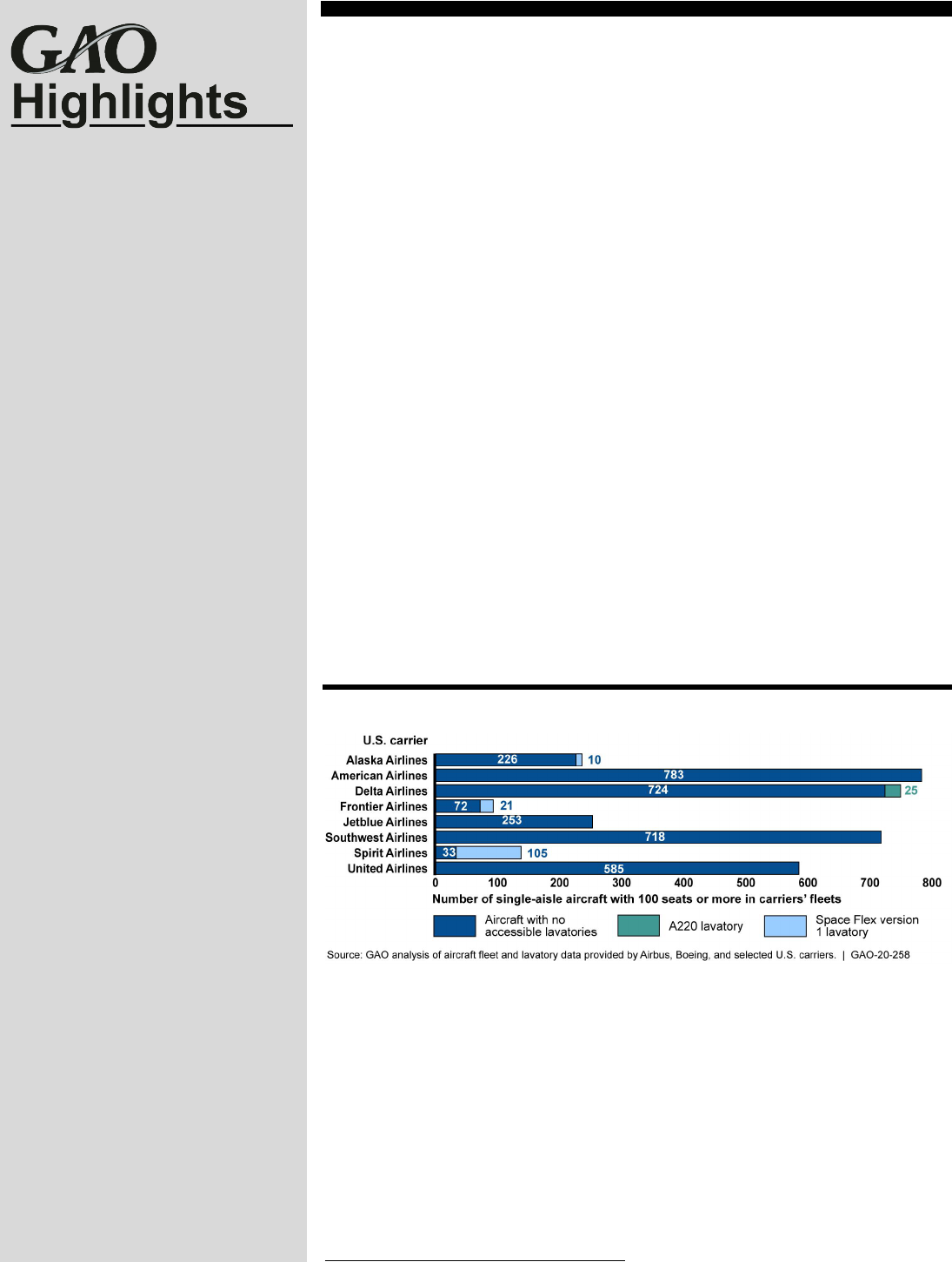
United States Government Accountability Office
Highlights of GAO-20-258, a report to
congressional committees
January 2020
AVIATION CONSUMER PROTECTION
Few U.S. Aircraft Have Lavatories Designed to
Accommodate Passengers with Reduced Mobility
What GAO Found
Aircraft manufacturers offer lavatories that carriers can provide and that are
designed to accommodate users of onboard wheelchairs, but carriers do not
choose to acquire this option for their single-aisle aircraft. We found designs for
lavatories that enable a passenger in an onboard wheelchair to use them, to
varying degrees. In recent years, both Airbus and Boeing—makers of single-
aisle aircraft—began offering similarly designed lavatories to provide greater
access for these passengers. For example, one design consists of two adjacent
lavatories located in the rear galley area with a connecting retractable wall to
allow for a wheelchair-bound passenger to enter one lavatory and transfer or be
transferred to the toilet in the other lavatory. Another design is a single lavatory
large enough to accommodate a passenger using an onboard wheelchair. Four
of the eight U.S. carriers—and only one of the four with the largest fleets—GAO
interviewed have Airbus aircraft with an adjacent lavatory design (Space Flex
version 1) or the single lavatory design found on the A220 aircraft, constituting
about 4.5 percent of the carriers’ combined single-aisle fleet (see figure). None of
the eight U.S. carriers have purchased a similar lavatory for their Boeing’s single-
aisle aircraft. Carrier officials told GAO that they consider many factors when
ordering lavatories, including financial and service tradeoffs such as the potential
to lose seating spaces, or reduced food and beverage service for passengers.
Lavatories Designed for Persons with Reduced Mobility on Selected U.S. Carriers’ Single-
Aisle Aircraft, as of November 2019
While the Department of Transportation (DOT) receives few complaints on
lavatory inaccessibility, consumer groups told GAO that the lack of an accessible
lavatory on single-aisle aircraft presents challenges for persons with reduced
mobility. For example, some passengers take precautionary measures to avoid
the need to use the aircraft lavatory and others avoid flying altogether.
Additionally, although some aircraft have wheelchair-accommodating lavatories,
they are not well advertised to passengers, making it difficult for passengers to
know whether their flight may have such a lavatory. To address such challenges
and the findings of its 2016 advisory committee, DOT issued, on December 16,
2019, a notice of proposed rulemaking to require carriers to install accessibility
features without changing the size of the lavatories. DOT also expressed intent
to study the costs and benefits of enlarging single-aisle aircraft lavatories to
enable use by passengers using the onboard wheelchair.
Why GAO Did This Study
Flying can pose significant challenges
for persons who rely on wheelchairs,
including the lack of wheelchair
accessible lavatories on most flights. In
1990, DOT required wheelchair
accessible lavatories on twin-aisle
aircraft used mainly for long flights. It
did not require them for single-aisle
aircraft, although DOT continued to
study the issue. Since 1990,
technological advances have enabled
single-aisle aircraft to fly longer
distances, and these aircraft now make
99 percent of domestic flights. In 2016,
a DOT advisory committee
recommended that DOT require
accessible lavatories in certain single-
aisle aircraft in the future.
The Federal Aviation Administration
(FAA) Reauthorization Act of 2018
included a provision that GAO examine
the availability and designs of
lavatories on commercial aircraft and
the ability of passengers with
disabilities to access them. This report
describes (1) what is known about
lavatory designs and accessibility for
persons with reduced mobility and (2)
the challenges wheelchair-bound
passengers and others face while
traveling on single-aisle aircraft without
accessible or functional lavatories.
GAO reviewed DOT’s guidance and
rulemaking and analyzed DOT’s
aircraft complaint data and fleet data
for the eight largest U.S. air carriers.
GAO interviewed officials from the
eight largest mainline carriers and
reviewed their fleet and lavatory data.
GAO also interviewed officials from
Airbus and Boeing and subsidiary
lavatory manufacturers, as well as
representatives from cabin crew labor
associations and consumer groups
representing persons with disabilities.

Page i GAO-20-258 Aircraft Lavatories
Contents
Letter 1
Background 5
Manufacturers of Single-Aisle Aircraft Offer Lavatories Designed
to Better Accommodate Persons with Reduced Mobility, but
Selected Carriers Rarely Choose to Acquire Them 9
Lack of Onboard Wheelchair-Accommodating Lavatories Can
Make Flying Difficult for Persons with Reduced Mobility, and
DOT Is Considering Rulemaking for Accessible Lavatories on
Single-Aisle Aircraft 15
Agency Comments 19
Appendix I: GAO Contact & Acknowledgements 21
Figures
Figure 1: U.S. Aircraft Departures for Domestic Flights by Aircraft
Type in 2018 6
Figure 2: Comparison of Standard and Contoured Lavatory
Designs Manufacturers Offer for Single-Aisle Aircraft 10
Figure 3: Example of a Single-Aisle Aircraft Lavatory Designed to
Accommodate an Onboard Wheelchair 11
Figure 4: Number of Lavatories Designed for Persons with
Reduced Mobility on Selected U.S. Carriers’ Single-Aisle
Aircraft, as of November 2019 14

Page ii GAO-20-258 Aircraft Lavatories
Abbreviations
ACAA Air Carrier Access Act
ACCESS Advisory Committee on Accessible Air Transportation
Advisory
Committee
ANPRM advance notice of proposed rulemaking
BTS Bureau of Transportation Statistics
DOT Department of Transportation
FAA Federal Aviation Administration
NPRM notice of proposed rulemaking
This is a work of the U.S. government and is not subject to copyright protection in the
United States. The published product may be reproduced and distributed in its entirety
without further permission from GAO. However, because this work may contain
copyrighted images or other material, permission from the copyright holder may be
necessary if you wish to reproduce this material separately.

Page 1 GAO-20-258 Aircraft Lavatories
441 G St. N.W.
Washington, DC 20548
Letter
January 7, 2020
The Honorable Roger Wicker
Chairman
The Honorable Maria Cantwell
Ranking Member
Committee on Commerce, Science, and Transportation
United States Senate
The Honorable Peter DeFazio
Chairman
The Honorable Sam Graves
Ranking Member
Committee on Transportation and Infrastructure
House of Representatives
For persons with reduced mobility, flying can pose significant challenges.
Embarking and disembarking the aircraft can be a lengthy process and
require assistance from airline personnel. After boarding, passengers with
reduced mobility may need to access aircraft lavatories and those
passengers unable to walk to the lavatory on their own likely would need
to rely on an onboard wheelchair designed to fit down narrow aircraft
aisles.
1
However, most lavatories on single-aisle aircraft are inaccessible
to these passengers unless they are able to stand and pivot from the
onboard wheelchair into the lavatory.
In 1990, in response to the Air Carrier Access Act (ACAA) of 1986,
2
the
Department of Transportation (DOT) implemented regulations that
included requirements for twin-aisle aircraft that historically have been
used for coast-to-coast and international flights to have at least one
1
DOT requires air carriers to provide onboard wheelchairs on most aircraft with more than
60 passenger seats that have an accessible lavatory and when requested by a passenger
with a disability even if the aircraft does not have an accessible lavatory. 14 C.F.R. §
382.65.
2
Pub. L. No. 99-435, 100 Stat. 1080 (codified as amended at 49 U.S. C. § 41705). The
ACAA prohibits discrimination on the basis of disability in air travel, whereas the
Americans with Disabilities Act of 1990, as amended, among other things, prohibits
discrimination and ensures equal opportunity and access for persons with disabilities in
public accommodations, commercial facilities and transportation by bus, rail, or any other
conveyance, other than by aircraft.

Letter
Page 2 GAO-20-258 Aircraft Lavatories
lavatory accessible by the aircraft’s onboard wheelchair.
3
DOT’s
accessible lavatory regulation does not apply to single-aisle aircraft,
which at the time of the rule’s promulgation were used primarily for
shorter flights. However, due to technological advancements, single-aisle
aircraft can now be used for longer flights, including longer coast-to-coast
and some international flights. Because of a lavatory’s size and
configuration, aircraft lavatories can also be challenging for other
passengers needing extra room, such as to accommodate their size or to
change a baby’s diaper.
Section 426 of the FAA Reauthorization Act of 2018 includes a provision
for us to review the availability and design of lavatories on commercial
aircraft, and the ability of passengers with disabilities to use accessible
aircraft lavatories.
4
Since twin-aisle aircraft are subject to the DOT
requirement to have at least one accessible lavatory this report focuses
on lavatories on single-aisle aircraft. In this report we: (1) describe the
lavatory designs for single-aisle commercial aircraft and the availability of
lavatories designed to provide access for persons with reduced mobility
on those aircraft and (2) discuss the challenges wheelchair-bound
passengers and others face traveling on single-aisle aircraft without
accessible or functional lavatories and efforts DOT has under way to
address these challenges.
To describe the lavatory designs for single-aisle aircraft and the
availability of lavatories designed to provide access for persons with
3
55 Fed. Reg. 8008 (Mar. 6, 1990) (codified as amended at 14 C.F.R. § 382.63). Among
other things, the 1990 regulations required new (ordered by the U.S. carrier after April 5,
1990, or delivered to the carrier more than 2 years after April 5, 1990) wide-body aircraft
with more than one aisle in which lavatories are provided to have lavatories that meet
certain specified accessibility criteria for passengers with mobility disabilities. Per DOT’s
current regulation, an “accessible lavatory” with respect to twin-aisle aircraft must permit a
qualified individual with a disability to enter, maneuver within as necessary to use all
lavatory facilities, and leave, by means of the aircraft’s on-board wheelchair; must afford
privacy to persons using the on-board wheelchair equivalent to that afforded ambulatory
users; and must provide door locks, accessible call buttons, grab bars, faucets and other
controls, and dispensers usable by qualified individuals with a disability, including
wheelchair users and persons with manual impairments. There are no federal regulations
requiring commercial passenger aircraft to have lavatories in the cabin. However, if there
is a lavatory on-board, DOT and FAA can and do have regulations over certain
components. For example, aircraft lavatories in passenger-carrying aircraft are required to
be equipped with a smoke detector system or equivalent and ashtrays.
4
Pub. L. No. 115-254, § 426, 132 Stat. 3186, 3339-40. Accessible lavatories may benefit
other persons with reduced mobility and other passengers (such as larger sized
passengers and those traveling with small children) as well.

Letter
Page 3 GAO-20-258 Aircraft Lavatories
reduced mobility on selected air carriers’ single aisle aircraft , we
reviewed DOT’s regulations, guidance, and rulemakings pertaining to
lavatories on commercial passenger aircraft. We also conducted a
literature search of government, trade, and academic publications for
studies and articles pertaining to aircraft lavatory accessibility,
functionality, and size. Specifically, we searched for articles published
between January 2009 and February 2019 in Scopus, EBSCO, ProQuest,
Dialog, West, and Aviation Week Information Network. We interviewed
officials from DOT, including the Federal Aviation Administration (FAA),
on federal requirements for aircraft lavatories. We analyzed commercial-
passenger aviation statistics from DOT’s Bureau of Transportation
Statistics (BTS) and we selected the top eight U.S. mainline carriers
based on 2018 passenger trips to include in our review. We interviewed
the eight carriers about their fleets and type of lavatories—including
lavatories designed to provide increased access for persons with reduced
mobility.
5
We reviewed and analyzed the carriers’ most recent corporate
reports and websites for additional information on their fleets and lavatory
types. These carriers’ fleets of single-aisle aircraft largely consist of
aircraft manufactured by Airbus (A220, A319, A320, and A321aircraft) or
various versions of Boeing’s 737 or 757 aircraft. We interviewed officials
from Airbus and Boeing and four manufacturers that make lavatories for
Airbus and Boeing aircraft about lavatory designs and their accessibility to
persons who rely on the aircraft’s on-board wheelchair. To obtain the
perspectives of cabin crew and passengers on the accessibility of aircraft
lavatories, we interviewed representatives of cabin-crew labor
associations and consumer groups (i.e., stakeholder groups), including
those representing persons with disabilities. Because there is no federal
requirement for or definition of what constitutes an accessible lavatory on
single-aisle aircraft, we focused on whether existing lavatories on those
5
We interviewed eight of the U.S. largest mainline carriers based on their 2018 passenger
trips: Alaska, American, Delta, Frontier, JetBlue, Southwest, Spirit, and United Airlines.
We did not include SkyWest and Republic Airlines because they are considered to be
regional carriers and typically do business for other airlines. Of the eight carriers we
selected, Alaska, Frontier, JetBlue, Southwest, and Spirit have only single-aisle aircraft in
their fleet. Southwest is the only carrier whose fleet consists of only Boeing 737aircraft,
while Frontier and Spirit fly only Airbus single-aisle aircraft. JetBlue flies Airbus and
Embraer single-aisle aircraft. American, Delta, and United have predominantly a mixture
of Airbus and Boeing single-aisle aircraft in their fleets. Delta also has a few McDonnell-
Douglas model aircraft in its fleet. We did not include aircraft that are generally considered
as regional aircraft in our analysis because they are neither within the scope of current
DOT accessible lavatory regulatory requirement nor within the scope of the wheelchair
accessibility related requirements of a November 2016 advisory committee proposal to be
used as the basis of an upcoming DOT rulemaking.

Letter
Page 4 GAO-20-258 Aircraft Lavatories
aircraft were designed to accommodate passengers with reduced
mobility, including those who rely on the onboard wheelchair to enter an
aircraft lavatory with an assistant’s aid in order to use the facilities.
To describe the challenges passengers with reduced mobility, including
those who require the use of the onboard wheelchair, may face related to
accessing aircraft lavatories, we obtained passenger complaint data from
DOT and the selected air carriers. We obtained data for passenger
complaints related to accessibility, inadequate facilities, and flight delays
for calendar years 2014 through 2018 from DOT’s Aviation Consumer
Protection Division’s consumer complaint database. We analyzed the
data to identify complaints related to lavatory function, size, and
accessibility. To assess the reliability of the complaint data, we
interviewed DOT officials about how the data were collected and used.
Because our interviews with DOT officials indicated that no changes had
been made to the processes used to collect and maintain the complaint
data, we also relied on the past data’s reliability assessment from our
recently issued airline consumer-protection report, an assessment that
found that the data were sufficiently reliable for our purposes.
6
We also
requested passenger complaint data for calendar year 2018 related to
lavatories from the eight selected U.S. carriers and obtained from data
from four carriers for this time period. We interviewed officials from the
eight selected U.S. carriers and obtained and reviewed their policies on
and the frequency of flights with non-functioning lavatories for calendar
year 2018. To understand the types of challenges wheelchair-bound
passengers face regarding lavatory accessibility, we interviewed
representatives of cabin-crew labor associations and consumer groups,
especially those representing persons with disabilities. We also
interviewed DOT officials and members of DOT’s Advisory Committee on
Accessible Air Transportation (ACCESS Advisory Committee), which
studied issues involved in requiring accessible lavatories on single aisle
aircraft in anticipation of possible rulemaking.
7
We conducted this performance audit from December 2018 to December
2019 in accordance with generally accepted government auditing
standards. Those standards require that we plan and perform the audit to
obtain sufficient, appropriate evidence to provide a reasonable basis for
6
See GAO, Airline Consumer Protections: Additional Actions Could Enhance DOT’s
Compliance and Education Efforts, GAO-19-76 (Washington D.C.: Nov. 20, 2018).
7
https://www.transportation.gov/access-advisory-committee.

Letter
Page 5 GAO-20-258 Aircraft Lavatories
our findings and conclusions based on our audit objectives. We believe
that the evidence obtained provides a reasonable basis for our findings
and conclusions based on our audit objectives.
Background
When DOT issued regulations requiring accessible lavatories on twin-
aisle aircraft in 1990, single-aisle aircraft were used primarily for shorter
distances. However, technological advancements—such as the use of
lighter, stronger composite materials—have enabled aircraft to fly longer
distances with greater fuel efficiency. As a result, both Airbus and Boeing
now offer single-aisle aircraft designs that can routinely fly 3,000 to
almost 4,000 nautical miles—or easily from coast to coast in the
continental U.S. as well as some overseas routes to and from the U.S. Of
the eight U.S. carriers we interviewed for this review, five of them operate
only single-aisle aircraft and the remaining three fly a mixture of single-
and twin-aisle aircraft. As shown in figure 1, twin-aisle aircraft are rarely
used for domestic flights by U.S. carriers. In 2018, 99 percent of U.S.
aircraft departures for domestic flights occurred on single-aisle aircraft:
71.7 percent on the larger single-aisle aircraft; 26.61 percent on smaller,
regional aircraft; and 0.68 percent on turbo jets.
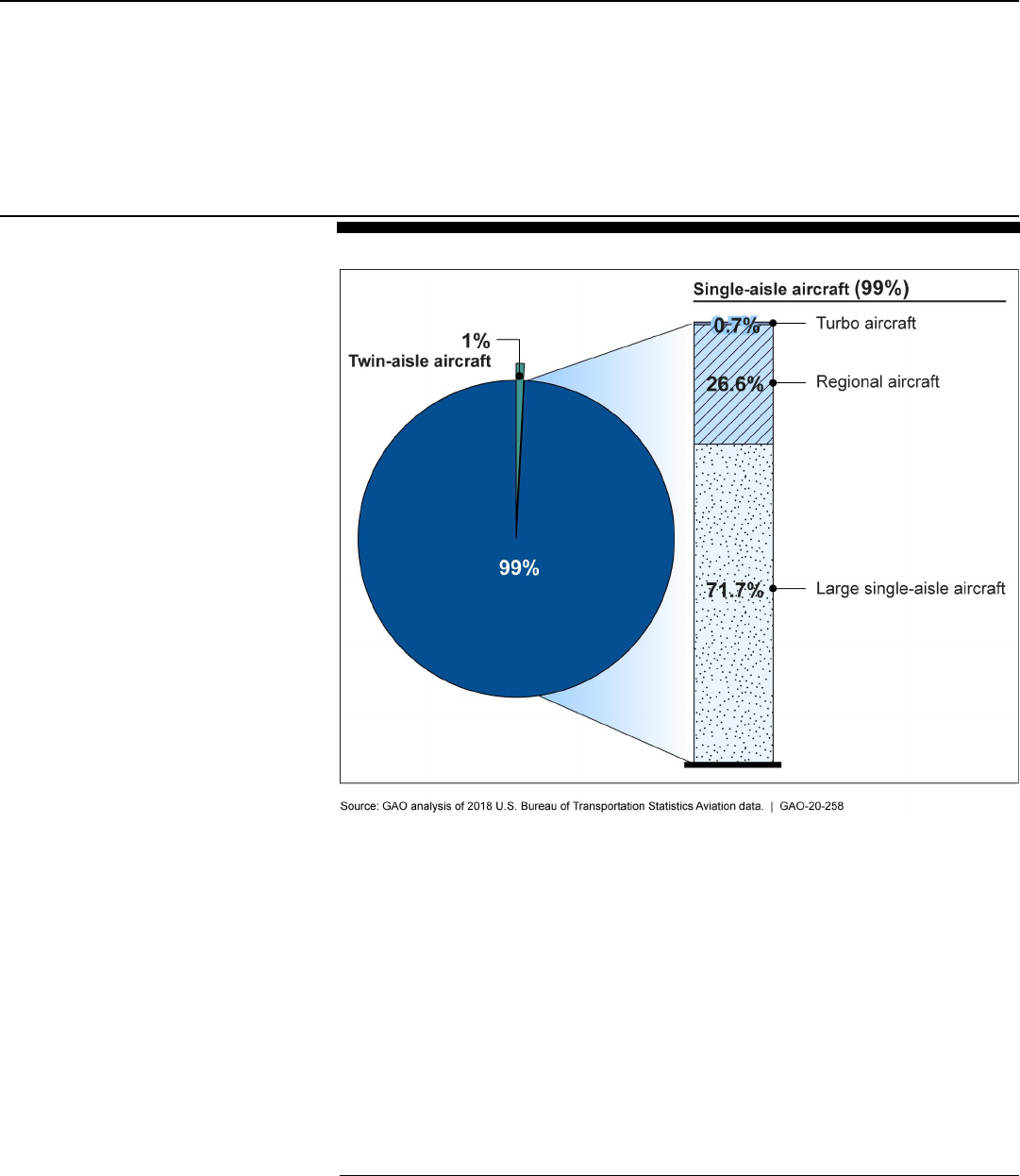
Letter
Page 6 GAO-20-258 Aircraft Lavatories
Figure 1: U.S. Aircraft Departures for Domestic Flights by Aircraft Type in 2018
According to the 2010 U.S. Census, 57 million Americans (roughly 1 in 5)
have a disability, of whom half have mobility issues that may require
accommodations when flying.
8
Furthermore, older Americans are
representing a greater share of the U.S. population. By 2020, 16.5
percent of the nation’s population will be over age 65, and by 2030, 20
percent of the population will be over age 65, and the likelihood of this
group’ needing assistance to access lavatories may increase as they age.
As an indication of the number of people with reduced mobility flying,
DOT’s monthly aviation travel data indicate that for the first 6 months of
8
For more information, see GAO, Passengers with Disabilities: Air Carriers’ Disability-
Training Programs and the Department of Transportation’s Oversight, GAO-17-541R
(Washington, D.C.: May 31, 2017).

Letter
Page 7 GAO-20-258 Aircraft Lavatories
2019, aviation passengers checked a total of 294,216 wheelchairs and
scooters.
9
Over the past 30 years, some efforts have been made to address the
issue of ensuring non-discriminatory treatment of aircraft passengers,
including access to aircraft lavatories. The enactment of the ACAA, which
prohibits discrimination by airlines on the basis of disability, charged DOT
with promulgating implementing regulations. DOT promulgated a final rule
in 1990, in which it required aircraft with more than one aisle (twin-aisle
aircraft) in which lavatories are provided to have at least one wheelchair
accessible lavatory. DOT, however, deferred setting regulations for
single-aisle aircraft, noting cost and feasibility concerns for carriers. Since
that initial regulation, DOT has taken several steps to study the issue of
accessible lavatories for single-aisle aircraft, but as of December 2019,
none of these actions has resulted in a regulation for accessible
lavatories in single-aisle aircraft. These steps include:
· DOT issued an advance notice of proposed rulemaking (ANPRM) to
study, among other things, the issue of accessible lavatories on
single-aisle aircraft that was issued in conjunction with its final rule
mandating that twin-aisle aircraft must have a lavatory that is
accessible to passengers who use wheelchairs.
10
· DOT created an advisory committee in 1992 to provide guidance to
DOT concerning access to lavatories on single-aisle aircraft for
persons with disabilities, including persons who rely on the aircraft’s
onboard wheelchairs.
11
In 1996, the committee reported to DOT that it
would be feasible to provide accessible lavatories on single-aisle
aircraft but acknowledged that there could be a cost to doing so.
· As part of a final rule that DOT issued in 2008 to amend the ACAA
regulations to include foreign carriers that fly to the U.S., DOT
acknowledged that requiring accessible lavatories on single-aisle
9
U.S. airlines with at least 0.5 percent of total domestic scheduled-service passenger
revenues are required to report data on wheelchairs, scooters, and mishandled baggage
to DOT. Although DOT issued a final rule on the reporting of these data, it did not start
collecting monthly data for wheelchair and scooter enplanement and mishandling until the
FAA Reauthorization Act of 2018 ( Pub. L. No. 114-254, §441, 132) mandated that the
compliance date for this rule be not later than 60 days after the enactment of the act,
which was signed on October 5, 2018.
10
See 55 Fed. Reg. 8078 (Mar. 6, 1990).
11
See 57 Fed. Reg. 424 (Jan. 6, 1992).

Letter
Page 8 GAO-20-258 Aircraft Lavatories
aircraft was an ongoing issue.
12
While the department noted that
accessible lavatories on single-aisle aircraft would benefit passengers
with disabilities, it also expressed concerns that revenue loss and
other cost impacts could be too great for the carriers. The department
said that it would continue to study the issue and review ongoing
developments.
· DOT published a notice of intent in December 2015 to explore the
feasibility of conducting a negotiated rulemaking concerning, among
other things, accessible lavatories on single-aisle aircraft for travelers
with disabilities.
13
· As a result of the 2015 notice of intent, DOT established the ACCESS
Advisory Committee in 2016—composed of representatives from air
carriers, aircraft manufacturers, disability groups, and other aviation
stakeholders. Its charge was to negotiate and develop a proposed
amendment to DOT regulations for DOT’s consideration concerning
accommodations for air travelers with disabilities that would address
whether to require accessible lavatories on new single-aisle aircraft,
among other issues. The committee noted that the issue of requiring
accessible lavatories on single-aisle aircraft merited exploration
because of two developments: (1) the increased use of single-aisle
aircraft on long flights, and (2) the availability of new accessible-
lavatory designs for single-aisle aircraft. In late 2016, the ACCESS
Advisory Committee agreed on proposed amendments that included
short-term and long-term solutions to address the challenges persons
with mobility impairments face when traveling on single-aisle aircraft.
The committee, taking into account costs to industry, recommended
accessible lavatories on new aircraft, did not recommend requiring the
retrofit of existing aircraft, and proposed a multi-tiered approach to
meet this goal.
14
12
73 Fed. Reg. 27614, 27625 (May 13, 2008).
13
80 Fed. Reg. 75953 (Dec. 7, 2015).
14
According to the committee’s proposal, all new aircraft delivered 3 years after the
effective date of the final rule should meet certain accessible features such as toilet seat
height, assist handles, lavatory controls, and call buttons. Aircraft ordered 18 years after
and delivered 20 or more years after the effective date of the final rule as well as any new
type design aircraft for which an application is filed with the FAA more than 1 year after
the effective date of the rule would be required to install at least one lavatory large enough
to permit a passenger with disabilities to perform both a seated independent and
dependent transfer from the onboard wheelchair with or without an assistant, in addition to
the accessible features. Under the committee’s proposal, the accessible lavatory must
enable a person ranging in sizes from the fifth percentile female to the 95
th
percentile male
to enter and use the facility.

Letter
Page 9 GAO-20-258 Aircraft Lavatories
· In 2019, DOT publicized its intent to issue notices of proposed
rulemaking regarding accessible lavatories to address the ACCESS
Advisory Committee’s final resolution, which we discuss in more detail
below.
ManufacturersofSingle-AisleAircraftOffer
LavatoriesDesignedtoBetterAccommodate
PersonswithReducedMobility,butSelected
CarriersRarelyChoosetoAcquireThem
AircraftManufacturersOfferaRangeofLavatoryDesigns
forSingle-AisleAircraft,IncludingDesignsto
AccommodateOnboardWheelchairs
Both Airbus and Boeing offer their customers a range of standard lavatory
designs.
15
For example, both Airbus and Boeing offer a lavatory with a
contoured design (see fig. 2). This design offers a smaller sink and
different dimensions than previous lavatories and has a contoured or
angled wall on the exterior allowing seats in the last row to recline into the
bottom portion of the contour. Air carriers can also choose to move the
last row of seats back into the contour and then add an extra row of seats
after making other changes to the configuration of seating rows. Airbus
and Boeing also offer flat-wall lavatory designs that are similar to the
standard flat-wall lavatories that had previously been available on single-
aisle aircraft for years but have slightly different interior dimensions.
Compared to the contoured lavatory design, this current flat-wall lavatory
design could offer a larger sink or more countertop space. According to
measurements and diagrams the aircraft and lavatory manufacturers
provided for these lavatory styles, some interior lavatory dimensions have
decreased while other dimensions have increased. For example, changes
in these two lavatory styles have resulted in increased interior space in
some areas, such as the sitting knee space and diagonal shoulder width,
and decreased space in other areas, such as the entry width and door
15
Larger single aisle aircraft in the fleets of the eight selected carriers we included typically
have multiple lavatories; for example, one in the front and two in the rear. Some larger
single-aisle aircraft may also have an additional lavatory in the middle of the aircraft.
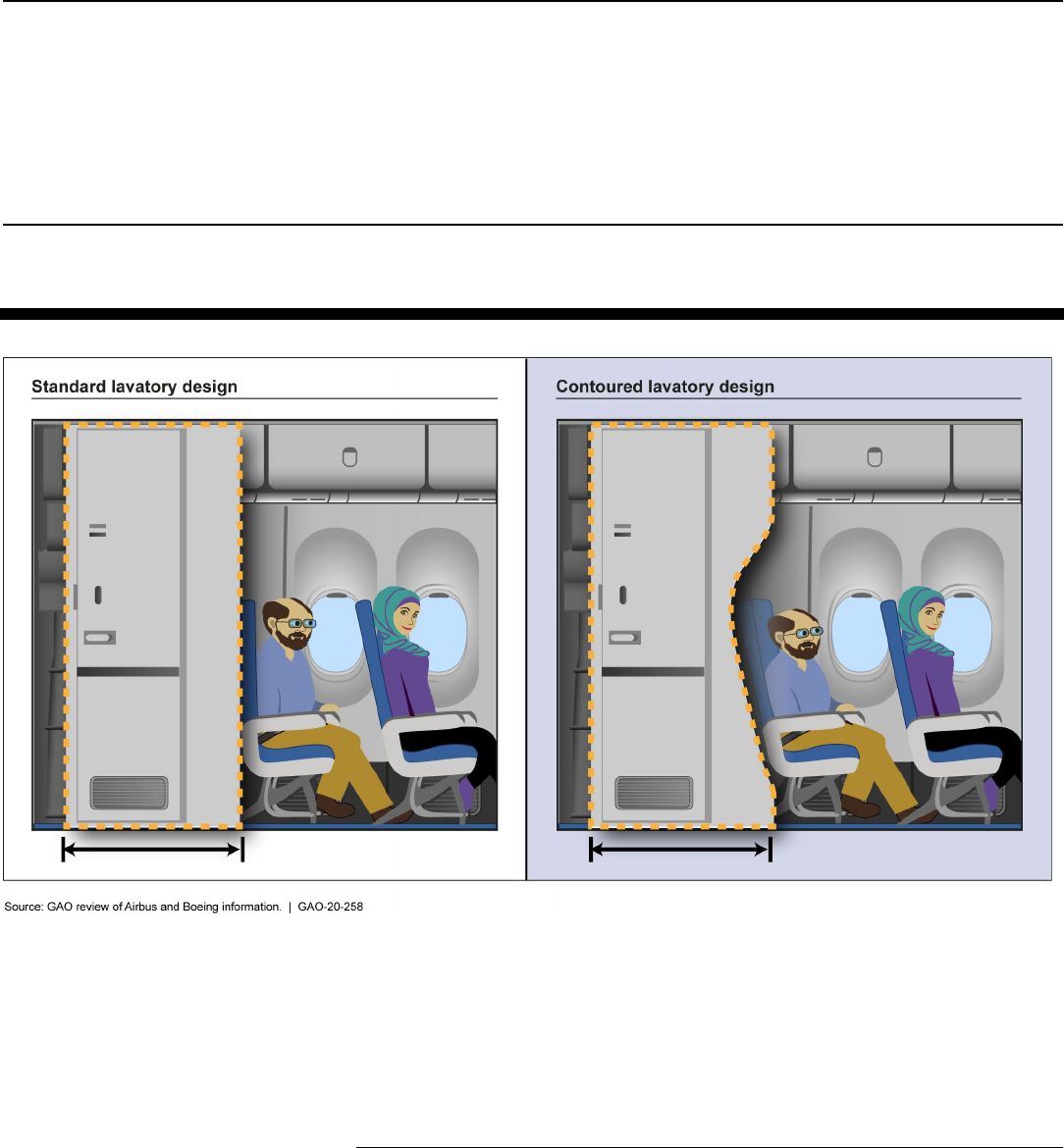
Letter
Page 10 GAO-20-258 Aircraft Lavatories
height.
16
These changes were to provide carriers options to help them
meet their business strategies.
Figure 2: Comparison of Standard and Contoured Lavatory Designs Manufacturers Offer for Single-Aisle Aircraft
In addition to making changes to the standard lavatories, since 2015, both
Airbus and Boeing offered lavatory configurations for their single-aisle
aircraft designed to provide greater access for passengers who rely on
the use of onboard wheelchairs.
17
According to officials for Airbus and
Boeing, both manufacturers use a design that connects two adjacent
lavatories with a retractable wall or partition. As shown in figure 3, when
the folding partition is open, this configuration is designed to enable the
person who relies on the aircraft-onboard-wheelchair to enter in one of
16
The changes in the lavatory dimensions generally are no more than a few inches.
Depending on the passenger, these differences could affect the passenger’s sense of
space within the lavatory.
17
In general, U.S. commercial aircraft with more than 60 passenger seats and that have an
accessible lavatory are required to have available onboard wheelchairs that are specially
designed to be wheeled down narrow aircraft aisles. 14 C.F.R. § 382.65.
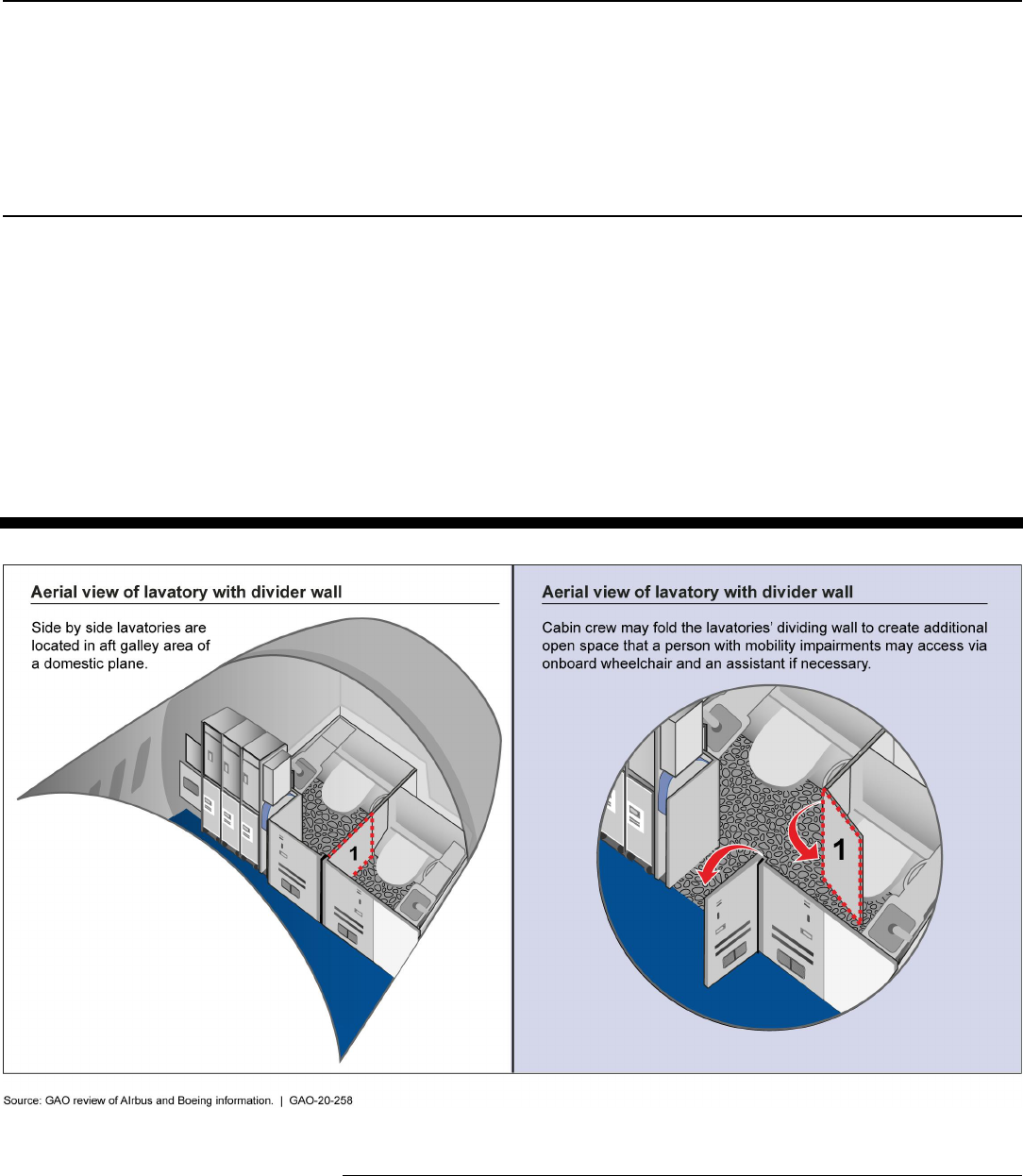
Letter
Page 11 GAO-20-258 Aircraft Lavatories
the lavatories and then transfer or be transferred to the toilet in the other
lavatory. While there are differences between the Boeing and Airbus
models, they operate similarly. Both the Airbus and Boeing designs are
for the rear of the aircraft and take up space in the area normally used for
the galley where food and drink carts are located for flight attendants’
access.
18
According to officials we interviewed from two carriers that have
purchased aircraft with this design, a reduced galley area is less of a
concern because their flights provide limited food and beverage service
and do not need a full galley. They said that the space where the
traditional lavatories were located could be used for other purposes, such
as more seats.
Figure 3: Example of a Single-Aisle Aircraft Lavatory Designed to Accommodate an Onboard Wheelchair
18
According to a selected aviation stakeholder, there also needs to be space outside of the
lavatory to accommodate the onboard wheelchair and its ability to maneuver into a
lavatory.

Letter
Page 12 GAO-20-258 Aircraft Lavatories
According to the manufacturers, the lavatory models that are designed for
greater accessibility accommodate the onboard wheelchair to varying
degrees.
· Airbus offers two designs to accommodate a passenger with an
onboard wheelchair. The Space Flex version 1 design consists of two
adjacent lavatories with a connecting retractable partition.
19
This
retractable partition can open to allow for a passenger who relies on
the aircraft onboard-wheelchair to enter the lavatory with or without
the help of an assistant.
20
A representative from a disability
organization was generally positive about the Space Flex version 1
and said it was a good design for both carriers and travelers with
disabilities. Airbus also offers another lavatory design specifically for
its A220 single-aisle aircraft model.
21
Airbus officials told us that it is a
single lavatory that is designed to accommodate a wheelchair but
cannot accommodate both a passenger in an onboard wheelchair and
an assistant.
22
· Boeing offers one lavatory designed to accommodate a passenger
using an onboard wheelchair for single-aisle aircraft for its 737 aircraft
family. This design, known as the Pax Plus, consists of two adjacent
lavatories with a removable partition designed to enable a wheelchair
and assistant to enter.
In addition, officials from the eight selected air carriers told us that their
crews are trained to assist passengers with reduced mobility to use
lavatories. These officials from the eight air carriers stated that they
provide their cabin crew with initial and, in some cases, recurrent training
about how to assist passengers with reduced mobility, pursuant to DOT
19
The Space Flex lavatories are designed to provide greater access for the Airbus 320
aircraft family, which consists of the A319, 320, and 321 aircraft models.
20
According to Airbus officials, there is a Space Flex version 2 lavatory design also
consisting of two adjacent lavatories. However, the version 2 lavatories are narrower, do
not have a retractable wall, and are not designed to accommodate an onboard wheelchair
and assistant. Rather, it can be designed with an optional transfer seat and grab bar
inside the lavatory that, depending on the extent of a person’s disability, a person can use
to switch from an onboard wheelchair, which remains outside the lavatory, to the toilet
seat.
21
This lavatory was originally designed for the Bombardier C Series aircraft. Now
produced in a partnership with Airbus, this aircraft was renamed the A220.
22
Airbus also offers a Dual Aft Lavatory Complex that is the A220 version of the two
adjoining Space Flex Lavatories for its A220 aircraft.

Letter
Page 13 GAO-20-258 Aircraft Lavatories
regulations.
23
DOT regulations further stipulate that if there is an on-board
wheelchair, the carrier must provide assistance to enable the passenger
to move to and from the lavatory if, in general, such assistance is
requested by or on behalf of a passenger with a disability.
24
OnboardWheelchair-AccommodatingLavatoriesAreNot
aCommonFeatureonSelectedU.S.Carriers’Aircraft
While aircraft manufacturers offer lavatories designed to accommodate
passengers with mobility impairments, carriers do not often choose to
acquire them. Of the eight U.S. carriers we interviewed, we found that
four have some aircraft—all of which are Airbus aircraft—with lavatories
that are designed to accommodate passengers with mobility impairments
to some extent. Only one of these carriers is among the four with the
largest number of aircraft in their fleet. Specifically, these four carriers
have either the Space Flex version 1 or the Airbus A220 lavatory. Despite
Boeing’s offering of the Pax Plus lavatories since 2017, Boeing officials
told us that as of November 2019 no U.S. carriers have ordered these
lavatories for their current or future single-aisle Boeing aircraft. Overall,
about 4.5 percent of the combined single-aisle fleet of the eight selected
carriers have lavatories designed to provide some measure of greater
access to passengers with reduced mobility, including those who require
the use of the onboard wheelchair (see fig.4).
25
23
Under 14 C.F.R. § 382.141(a)(1(i)), for example, carriers operating aircraft with 19 or
more passenger seats are required to provide training to personnel who deal with the
traveling public concerning, among other things, federal regulations affecting the provision
of air travel to passengers with a disability. In addition, such carriers are required to
provide training on their procedures concerning the provision of air travel to such
passengers including the proper and safe operation of any equipment used to
accommodate passengers with a disability. 14 C.F.R. § 382.141(a)(1)(ii). In other words,
the onboard wheelchair and the lavatory retractable partition would be considered as
equipment used to accommodate a passenger with disabilities.
24
14 C.F.R. § 382.111. However, according to DOT regulations, carriers are not required
to lift or carry a passenger with a disability in moving to and from the lavatory or provide
assistance within the lavatory. 14 C.F.R. §§ 382.111, 382.113.
25
Specifically, only three airlines have the Space Flex version 1 lavatory (10 for Alaska
Airlines; 21 for Frontier; and 105 for Spirit Airlines). Delta has 25 A220 aircraft with the
lavatory that can accommodate the onboard wheelchair but not with an assistant.
According to officials of Alaska Airlines, the 10 Airbus aircraft were originally Virgin
America aircraft, which Alaska acquired in 2016.
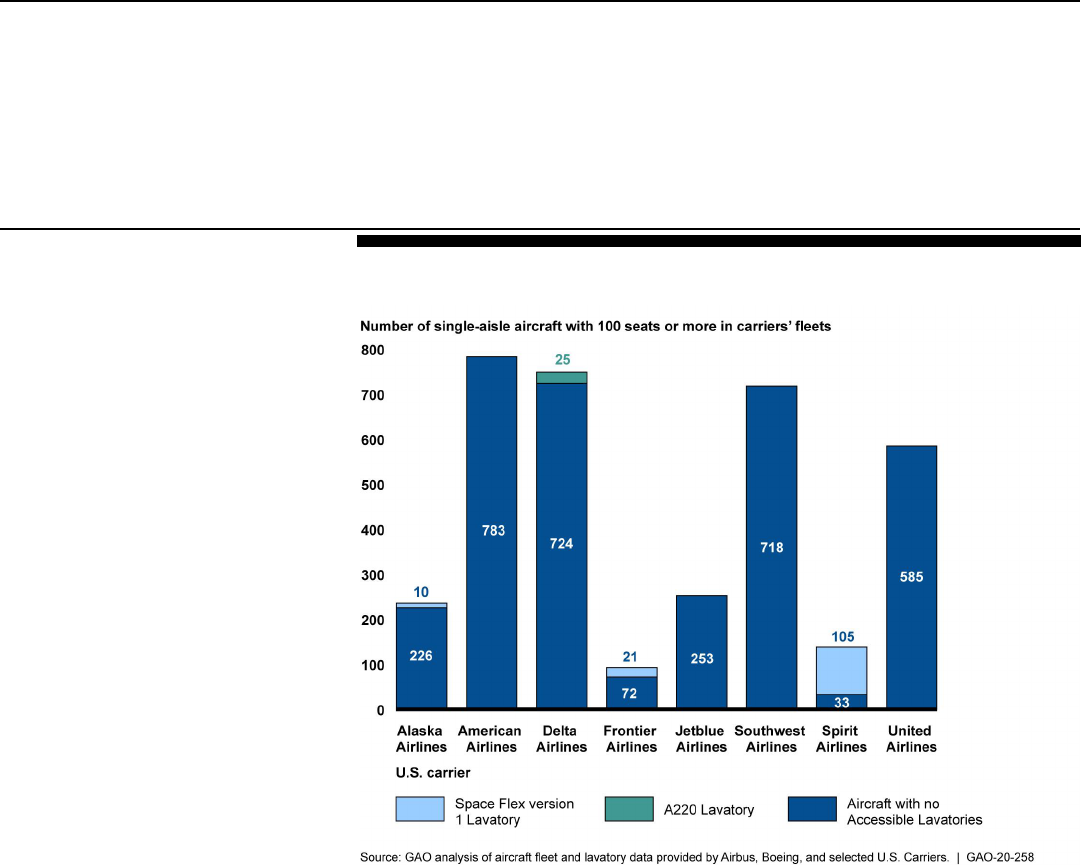
Letter
Page 14 GAO-20-258 Aircraft Lavatories
Figure 4: Number of Lavatories Designed for Persons with Reduced Mobility on
Selected U.S. Carriers’ Single-Aisle Aircraft, as of November 2019
According to the carriers we interviewed, they consider the configuration
of the aircraft among other factors, including their business strategy,
when ordering lavatories for new aircraft. Providing a lavatory designed to
accommodate onboard wheelchairs on single aisle aircraft may require
financial tradeoffs for carriers, such as reducing the number of revenue
generating seats in the aircraft cabin. According to airline officials, this
reduction can result in higher costs for carriers that subsequently might
be passed onto consumers through higher fares. Officials from all eight
selected carriers, however, stated that all of their aircraft lavatories have
features designed to increase access to certain lavatory functions, such
as assist handles or grab bars, accessible call buttons, door locks, and
faucets that passengers with disabilities can use.
Carrier officials also stated that they need to make trade-offs between
competing priorities; for example, taking into account how onboard
wheelchair-accommodating lavatory designs may affect food service.
According to officials from two carriers, an onboard wheelchair-
accommodating lavatory can result in less galley space, and a full galley

Letter
Page 15 GAO-20-258 Aircraft Lavatories
at the back of the aircraft is needed for the type of services they wish to
provide to their customers without compromising customer seating
capacity. Conversely, officials from two other carriers told us that trading
galley space for onboard wheelchair-accommodating lavatories did not
affect their food service, as they do not provide full meal service. For
example, they said that because they did not need the full galley space,
the Space Flex lavatory enabled them to add not only a lavatory that
accommodates onboard wheelchairs but also an additional row of
passenger seats.
LackofOnboardWheelchair-Accommodating
LavatoriesCanMakeFlyingDifficultfor
PersonswithReducedMobility,andDOTIs
ConsideringRulemakingforAccessible
LavatoriesonSingle-AisleAircraft
WhileComplaintDataAreLimited,GroupsAdvocatingfor
PersonswithReducedMobilityStatedThattheLackof
AccessibleLavatoriesMakesFlyingDifficult
Representatives from stakeholder groups we interviewed told us that the
lack of accessible lavatories makes flying challenging for persons with
reduced mobility. They described how some passengers with reduced
mobility take precautionary measures to avoid the need to use an aircraft
lavatory, such as severely limiting food and fluid intake in advance of the
flight, risking dehydration; using a catheter; or wearing a protective
undergarment. Some passengers with reduced mobility reportedly may
avoid long flights altogether by purchasing flights with connections or
layovers. However, according to one stakeholder group, these
precautionary measures may not alleviate the fear and anxiety that
passengers who rely on the onboard wheelchair to get to the lavatory
may face during air travel as there is always the possibility of having to
deal with circumstances beyond their control. For example, unforeseen
events such as increased flight time or delays in getting to the gate can
increase the time a passenger has to postpone attending to normal bodily
functions. Finally, stakeholder groups report that passengers may choose
not to travel at all, or to drive rather than fly, choices that may increase
the cost and time of travel, particularly if it involves an overnight stay.

Letter
Page 16 GAO-20-258 Aircraft Lavatories
Even when an aircraft has a lavatory that can accommodate an onboard
wheelchair, which exists on about 4.5 percent of the combined fleet of
single-aisle aircraft for the 8 airlines included in our review, passengers
may have difficulty determining whether or not their flight has such a
lavatory.
26
According to officials of air carriers, passengers may call the
carriers’ customer service department for this information, although not all
phone representatives may have this information readily available. In
addition, our review of selected carriers’ websites revealed that most do
not have information about which flights or aircraft may have such a
lavatory, although we found that two carriers include descriptions of
aircraft amenities or diagrams denoting onboard wheelchair-
accommodating lavatories. However, even if this information were made
available, it may not guarantee that a passenger with a mobility
impairment will be able to fly on an aircraft with this type of lavatory
because air carriers sometimes switch aircraft at the last minute without
notice, such as when, for example, an aircraft has a mechanical problem.
While stakeholders described challenges, neither air carriers nor DOT
receive a large number of complaints regarding the lack of lavatories
designed to accommodate passengers who use onboard wheelchairs or
lavatories in general. As we have previously reported, DOT receives and
processes complaints from passengers and uses complaint data to help
identify which carriers to inspect for consumer protection violations.
27
From 2014 through 2018, DOT received 59,846 complaints about U.S.
carriers. Of these, we reviewed 1,263 complaints related to accessibility,
inadequate facilities, and flight delays and identified 69 complaints about
lavatories in general and 5 about the accessibility of lavatories. Of the 69
lavatory complaints identified:
· 64 related to non-functioning lavatories (e.g., non-operational or
unclean lavatories, sinks lacking running water, etc.);
26
Under 14 C.F.R. § 259.5, carriers operating to, from, or within the United States, with a
least one aircraft having a designed seating capacity of 30 or more seats are to adopt a
customer service plan that, among other things, addresses the provision of information on
lavatory availability on the selling carrier’s website, and upon request, from the selling
carrier’s telephone reservations staff.
27
See GAO, Airline Consumer Protections: Additional Actions Could Enhance DOT’s
Compliance and Education Efforts, GAO-19-76 (Washington, D.C.: November 2018). Most
of DOT’s airline passenger complaints fall into only a few complaint categories. In 2018,
DOT reported that the top four complaint categories accounted for about 70 percent of all
complaints it receives about airlines. These complaints were about flight problems,
baggage issues, reservations/ticketing/boarding, and customer service.

Letter
Page 17 GAO-20-258 Aircraft Lavatories
· 5 related to lavatories being inaccessible by persons with disabilities
(e.g., lavatory grab bars at an improper height, passenger using
onboard wheelchair unable to enter lavatory);
28
and
· 2 related to lavatory size (e.g., lavatory size has been reduced).
We also discussed lavatory-related complaints with the eight selected air
carriers, three of which reported that these complaints made up about 1
percent or less of the total passenger complaints they received in 2018.
29
Four air carriers reported that lavatory complaints related to accessibility
made up an even smaller portion—around 0.05 percent or less of their
total passenger complaints in 2018.
However, the small number of complaints related to lavatory accessibility
does not necessarily indicate that individuals who use onboard
wheelchairs are not affected by inaccessible aircraft lavatories, as some
may choose not to fly,
30
and others may take precautionary measures as
described above to avoid having to use the aircraft lavatory. Furthermore,
because accessible lavatories are not required on single-aisle aircraft and
there is no expectation that the lavatory would be accessible, passengers
may not see grounds to complain or may not take the time to submit a
complaint. As we have previously reported, complaint data are inherently
limited because, according to academic literature, a substantial portion of
dissatisfied individuals never complain and are therefore not represented
in the complaint data. Finally, when they do complain, their complaints
may not be representative of other individuals.
31
We also found that there were very few complaints about non-functioning
lavatories. As noted above, DOT received 64 passenger complaints on
non-functioning lavatories. Carrier officials also told us that they have
received few complaints about non-functioning lavatories. According to
28
The sum of individual complaint categories exceeds total complaints as two complaint
records contained complaints about size and inaccessibility.
29
Three or four of the air carriers—depending on the nature of the complaint—provided
comparable data. The other four carriers included in our review either did not provide
complaint data or the data they provided were not from a comparable 2018 time period. In
the case of the latter, the levels of aircraft lavatory complaints reported were also very low.
30
In a 2016 rulemaking effort to require U.S. carriers to report monthly the number of
mishandled wheelchairs, DOT acknowledged that some persons with disabilities may be
reluctant to fly, indicating that there may be barriers to travel. See 81 Fed. Reg. 76300,
76304 (Nov. 2, 2016).
31
GAO-19-76.

Letter
Page 18 GAO-20-258 Aircraft Lavatories
the air carrier officials we interviewed, depending on the flight, some
flights may operate with one or more lavatories not functioning. However,
most carrier officials reported that according to data they collect, this
occurred on less than 2 percent of flights. In such instances, some carrier
officials stated they would notify passengers of nonoperational lavatories
to give them the opportunity to use the airport lavatories prior to boarding.
These officials also stated that if all lavatories are inoperable it is the
responsibility of the pilot—in consultation with flight dispatchers—to
decide if the aircraft will take off or, if lavatories become inoperable during
a flight, to divert to an airport other than the destination. Carriers further
noted that flights with no operational lavatories are extremely rare.
DOTHasIntroducedRulemakingandHasOtherEfforts
UnderWaytoHelpAddressDifficultiesFacedbyAir
TravelerswithDisabilities
As previously noted, in late 2016, the ACCESS Advisory Committee
reached a consensus on proposed amendments that would require
accessible lavatories on single-aisle aircraft. DOT announced in 2019 that
it would address the issue in rulemaking.
32
On December 16, 2019, DOT
issued a notice of proposed rulemaking to solicit comments on short-term
accessibility improvements on single-aisle aircraft through the installation
of accessibility features within the lavatory, such as assist handles, call
buttons, and lavatory controls, without changing the size of lavatories.
33
In
addition, DOT has announced its intention to issue an advanced notice of
proposed rulemaking to address long-term accessibility improvements,
also addressed by the Advisory Committee, and to solicit comments and
gather information on the costs and benefits of requiring carriers to
increase the size of the single-aisle lavatory on new aircraft models to
enable passengers using an onboard wheelchair to enter and use the
lavatory with an assistant, if necessary.
32
In late 2018, the Paralyzed Veterans of America, et al., petitioned the United States
Court of Appeals for the Tenth Circuit (No. 18-1465) to require DOT to issue a proposed
rule governing single-aisle aircraft lavatory accessibility. DOT asserted that such relief was
inappropriate where the Secretary is poised to issue a proposed rule. In May 2019, the
court abated (suspended) the matter pending further order of the court, and ordered DOT
to file a status report every 45 days regarding their progress on issuing the notice of
proposed rulemaking.
33
85 Fed. Reg. 27 (Jan. 2, 2020).

Letter
Page 19 GAO-20-258 Aircraft Lavatories
In addition to the two rulemakings, DOT has recently established another
advisory committee. The ACAA Advisory Committee was created in
response to a requirement in the FAA Reauthorization Act of 2018, has a
2-year charter, and is required to report its findings to both DOT and
Congress on current DOT regulations on barriers to persons with
disabilities who want to travel by air. The ACAA Advisory Committee is
also required to determine the extent to which DOT is addressing those
barriers, recommend improvements to implement the ACAA, and improve
the flying experience for travelers with disabilities. The committee—
comprised of members representing aircraft manufacturers, national
disability organizations, air carriers, and airports—plans to hold its first
meeting in early 2020. According to DOT officials, although it is within the
purview of this committee to consider issues regarding accessible
lavatories, it does not plan to do so at the present time given that the two
proposed rulemakings are proceeding and that there is a Congressional
mandate for the committee to report on other issues within 6 months of
the first meeting.
34
AgencyComments
We provided a draft of this report to DOT for review and comment. DOT
provided technical comments, which we incorporated as appropriate.
34
Section 438(b) of the FAA Reauthorization Act of 2018 mandated that the ACAA
Advisory Committee report on ticketing, pre-flight seat assignment, access to bulkhead
seating, and stowage of assistive devices within 6 months of the committee’s first meeting.

Letter
Page 20 GAO-20-258 Aircraft Lavatories
We are sending copies of this report to the appropriate congressional
committees, DOT, and other interested parties. In addition, the report is
available at no charge on the GAO website at http://www.gao.gov.
If you or your staff have questions concerning this report, please contact
me at (202) 512-2834, or [email protected]. Contact points for our Offices
of Congressional Relations and Public Affairs may be found on the last
page of this report. GAO staff who made key contributions to this report
are listed in appendix I.
Andrew Von Ah
Director, Physical Infrastructure Issues

Appendix I: GAO Contact &
Acknowledgements
Page 21 GAO-20-258 Aircraft Lavatories
AppendixI:GAOContact&
Acknowledgements
GAOContact
StaffAcknowledgments
In addition to the individual named above, other key contributors to this
report were Ed Laughlin, Assistant Director; Martha Chow, Analyst-in-
Charge; James Geibel; Geoffrey Hamilton; Elke Kolodinski; Gail Marnik;
Malika Rice; Amy Rosewarne; Travis Schwartz; Pamela Snedden; and
Elizabeth Wood.
(103191)

GAO’sMission
The Government Accountability Office, the audit, evaluation, and investigative
arm of Congress, exists to support Congress in meeting its constitutional
responsibilities and to help improve the performance and accountability of the
federal government for the American people. GAO examines the use of public
funds; evaluates federal programs and policies; and provides analyses,
recommendations, and other assistance to help Congress make informed
oversight, policy, and funding decisions. GAO’s commitment to good government
is reflected in its core values of accountability, integrity, and reliability.
ObtainingCopiesofGAOReportsandTestimony
The fastest and easiest way to obtain copies of GAO documents at no cost is
through our website. Each weekday afternoon, GAO posts on its website newly
released reports, testimony, and correspondence. You can also subscribe to
GAO’s email updates to receive notification of newly posted products.
OrderbyPhone
The price of each GAO publication reflects GAO’s actual cost of production and
distribution and depends on the number of pages in the publication and whether
the publication is printed in color or black and white. Pricing and ordering
information is posted on GAO’s website, https://www.gao.gov/ordering.htm.
Place orders by calling (202) 512-6000, toll free (866) 801-7077, or
TDD (202) 512-2537.
Orders may be paid for using American Express, Discover Card, MasterCard,
Visa, check, or money order. Call for additional information.
ConnectwithGAO
Connect with GAO on Facebook, Flickr, Twitter, and YouTube.
Subscribe to our RSS Feeds or Email Updates. Listen to our Podcasts.
Visit GAO on the web at https://www.gao.gov.
ToReportFraud,Waste,andAbuseinFederal
Programs
Contact FraudNet:
Website: https://www.gao.gov/fraudnet/fraudnet.htm
Automated answering system: (800) 424-5454 or (202) 512-7700

CongressionalRelations
Orice Williams Brown, Managing Director, [email protected], (202) 512-4400,
U.S. Government Accountability Office, 441 G Street NW, Room 7125,
Washington, DC 20548
PublicAffairs
Chuck Young, Managing Director, [email protected], (202) 512-4800
U.S. Government Accountability Office, 441 G Street NW, Room 7149
Washington, DC 20548
StrategicPlanningandExternalLiaison
James-Christian Blockwood, Managing Director, [email protected], (202) 512-4707
U.S. Government Accountability Office, 441 G Street NW, Room 7814,
Washington, DC 20548
